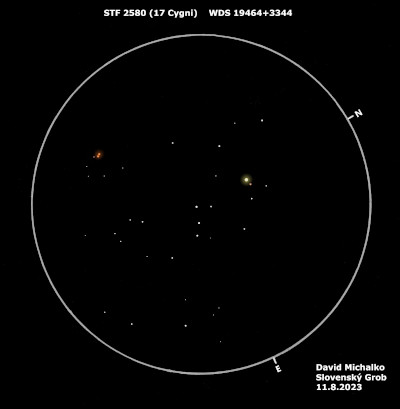Cyg
☀5.06/9.25mag
Ø
25''

STF 2580 (17 Cygni) is a highly interesting and relatively complex quintuple system located approximately 2°SW of Eta Cygni. It consists of the binary system STF 2580AB and the triple system STF 2576FGJ. The primary component of STF 2580AB (A) is a yellow-white main-sequence star of spectral class F7V, with a mass of 1.24 and a diameter of 1.53 times that of the Sun. The companion (B) is an orange main-sequence star of spectral class K6V, with a mass of 0.65 solar masses. These components orbit around their common center of mass approximately every 7900 years, although some sources suggest only 6200 years. STF 2576FGJ consists of a close pair of orange main-sequence stars of spectral class K3V (FG), orbiting their common center of mass once every 232 years. The third member of this system (J) is likely a common proper motion (CPM) companion—a red dwarf of spectral class M0V. Interestingly, according to the Washington Double Star Catalog (WDS), the gravitational relationship exists only between G and J, with F and J reportedly not gravitationally influencing each other. These two systems (STF 2580 and STF 2576) orbit around their common center of mass once every 3.7 million years and are separated by more than 16000 AU.
100mm - _ Observing 17 Cygni_ was one of the most challenging experiences for me. Firstly, it requires orienting oneself in the mutual relationships of this system and identifying its components on a star map. The observation itself is further complicated by the radiant background of the Milky Way, which reduces the contrast of fainter stars, and the abundance of stars complicates orientation. Components AB can be easily separated even at lower magnifications. A appeared yellow-white, and B appeared orange-brown. F and G nicely separated at 138x, thanks to their almost identical magnitudes; both stars were distinctly orange. Around the FG pair, several faint stars were present, and after plotting, one of them was approximately in the direction corresponding to component J.